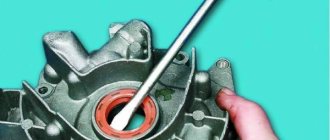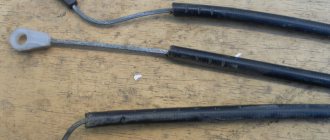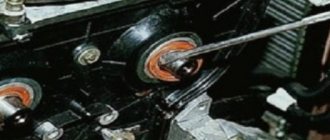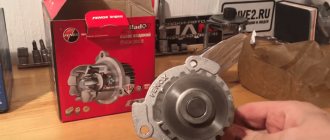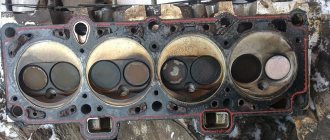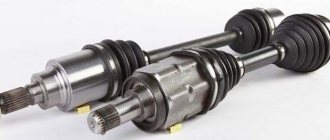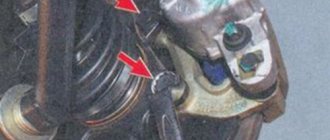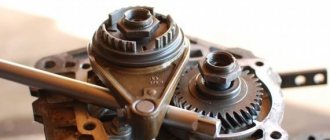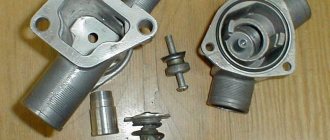There are two cuffs: front and back. To replace them, it is necessary to disassemble several bulky components, for example, the timing mechanism or clutch assembly. Depending on which of the seals leaked, the work occurs according to different algorithms. Let's figure out how to replace the crankshaft oil seal on a VAZ-2109, depending on its location.
Signs of malfunction and methods for checking VAZ 2109 oil seals
The main sign indicating a malfunction not only of the crankshaft oil seals, but also in general of a violation of the tightness of the oil system is the appearance of oil smudges at the junction of various elements, such as the oil pan, in the front or rear of the engine, where the oil seals are actually located .
If you find oil leaks, then:
- check the crankcase ventilation system;
- see if the system hoses are kinked;
- check the system pressure.
If during the inspection no other leaks are detected, then replace the oil seal. To replace the front crankshaft oil seal of a VAZ 2109, you need to prepare a standard set of tools. We will need:
- open-end wrenches or a set of heads “10”, “13”, “19”;
- large screwdriver;
- new o-rings;
- clean rags;
- container or bucket for draining lubricant.
Changing half rings
To do this, you do not need to remove the crankshaft of the VAZ 2109. Replacing the oil seal, half-rings, liners (the crankshaft sensor, we note right away, must also be removed) begins with searching for the location of the elements. These parts are located on the sides of the central (third) main bearing. A yellow ceramic-metal half-ring is installed on the side of the middle crankshaft support. On the other hand - steel-aluminum. The elements must fit tightly, and depending on the wear of their sockets, they come in three sizes:
- standard;
- first repair;
- second repair.
Which crankshaft oil seal to install on a VAZ 2109, when to change it?
Original number 2108-1005034, average price 62 rubles.
Analogues:
- Elring 546.968 — 57 rub.
- Reinz 80-33653-10 — 49 rub.
- Corteco 12016518B — 83 rub.
Replacement frequency : every three years or every time the timing belt is replaced.
1
Using a 17 key, unscrew the oil pan plug and drain the oil into a container with a volume of at least 4 liters. The duration of draining the oil is at least 10 minutes. We wrap the drain plug.
2
Using a 10mm wrench, unscrew the two side bolts of the front timing cover.
3
And another one in the center. Remove the timing cover. Remove the generator drive belt.
4
Remove the right wheel and the plastic shield of the engine compartment. Using the “19” head, turn the crankshaft clockwise by the pulley mounting bolt.
5
Rotate the lower pulley until the mark on the camshaft toothed pulley aligns with the installation tab on the rear timing cover.
6
By removing the rubber plug in the upper part of the clutch housing, we make sure that the mark on the flywheel is located opposite the slot in the clutch housing cover.
7
This is how the mark is located on the engine flywheel with the gearbox and cylinder head removed.
8
We fix the crankshaft from turning by inserting a screwdriver through the hole in the clutch housing between the flywheel teeth.
9
Unscrew the bolt securing the generator drive pulley.
10
Remove the generator drive pulley.
11
Using a 17mm wrench, loosen the nut securing the tension roller. Turn the tension roller to a position in which the belt will be loosened as much as possible. Remove the timing belt.
12
Use two screwdrivers to pry up the crankshaft toothed pulley and remove it from the crankshaft toe.
14
Use a screwdriver to pry up the seal and remove it from the cover.
16
Lubricate the working edge of the new oil seal with engine oil and press it in with a suitable piece of pipe.
17
We assemble and install the timing belt in the reverse order. Add oil.
Welcome! Today you clicked on this link not by chance, since you are looking for detailed instructions on how to replace the front crankshaft oil seal, then we will provide it to you. The instructions for replacing the oil seal will apply only to cars of the Samara family. At the end of the article you can find a visual video that describes in detail the replacement of the crankshaft oil seal!
Summary:
Where is the front crankshaft oil seal located? • It is located in the oil pump cover itself, or to be more precise, it is located on the toe of the crankshaft. In order to see it you will have to remove the timing belt cover. (You will learn how to remove the timing belt cover in this article as we proceed)
• When the cover is removed, turn your attention to the lowest crankshaft pulley, which is indicated by a red arrow in the photo. It is under this pulley that the front oil seal is located.
When should you replace the front crankshaft oil seal? It must be replaced if:
1. The appearance of various kinds of cracks, breaks and defects on it.
2. The oil seal must also be replaced when it becomes oily, that is, when oil leaks are detected on the oil seal.
Note! It is not always necessary to immediately change the oil seal when oil leaks are detected, because oil can also ooze through the oil seal for the following reasons:
- When the crankcase ventilation system is dirty. (You can learn how to clean the ventilation system from the article specifically dedicated to: “Cleaning the system”)
- And also when the hoses of the crankcase ventilation system are strongly pinched. In this case, inspect all system hoses for kinks and correct the problem if possible.
What's next?
After draining the oil from the car engine, unscrew and remove the pan. Then the two bolts securing the middle main bearing cover are unscrewed. It is removed and the gap between the bearing and the half ring is measured using feeler gauges. You should add to it the standard parameter of 2.31 mm.
As a result, the required size of the new half ring will be obtained. After this, by displacing the old half-ring, they are installed in their nests. It is important that the new element fits in freely. After the work has been done, all removed parts are installed back.
How to replace the front crankshaft oil seal on a VAZ 2108-VAZ 21099?
Removal: 1) At the very beginning of the operation, remove the “Gas Distribution Mechanism” belt from all pulleys. (For information on how to remove the belt, see the article: “Replacing the timing belt”)
3) Then remove the toothed pulley from the crankshaft nose.
4) Now, using a screwdriver, pry and remove the crankshaft key so that it does not get lost when removing the oil seal.
5) Next, without removing the screwdriver, use it to pry the crankshaft oil seal and then remove the oil seal from the cover.
Installation: 1) Before installing the new oil seal, lubricate its working edge with engine oil.
2) Then press the oil seal into place using a socket, or using a piece of pipe of a suitable size, or using a mandrel.
3) After pressing, install the new oil seal in the reverse order of removal, installing a key in the groove of the crankshaft, and the crankshaft toothed pulley on the toe.
Note! When all the parts are installed, install the “Gas Distribution Mechanism” belt in its place!
Additional video clip: Below we have prepared a video clip especially for you, which describes in detail the replacement of the crankshaft oil seal, so watch and delve into it.
The content of the article:
Based on the types of repairs that a car enthusiast is able to perform on his own, one can judge his qualifications and experience in operating a car. If for the owner of a 9th VAZ series car, replacing the crankshaft oil seal of a VAZ 2109 does not present any difficulties, then we are dealing with a trained car owner who will not contact a car service center for every trivial breakdown.
When and why is the VAZ 2109 crankshaft oil seal replaced?
Replacing the crankshaft oil seal is a rather complicated procedure, but quite doable even in an ordinary garage that does not have special devices and professional tools.
Any car owner with some technical knowledge knows that the oil seal is designed to prevent lubricants from leaking. If a shaft or axle comes out of any mechanism containing lubricating fluid inside, then an oil seal must be installed that will not allow the lubricant to leak out. There are many components in a car where oil seals are installed, but the most important one is the engine crankshaft. The engine block of any car has a very complex lubrication system, and at the front and rear of the block, the edges of the crankshaft must protrude outward. The timing gear is attached to it at the front, and the clutch at the rear. Naturally, the lubricant should not leave the block.
The oil seal is a ring with a rigid outer ring and an elastic inner edge into which the shaft is inserted. The spring-reinforced edge compresses the shaft and does not allow oil to leak out. Since the oil seal loses elasticity or is damaged during operation, oil begins to leak and creates many problems for the driver. That is why it is important to know how to replace the crankshaft oil seal on a VAZ 2109. The procedure for changing the front and rear oil seals differs significantly due to the structural features of the engine.
Replacing the crankshaft oil seal - preparing the workplace
Full preparation for any repair work is half the success. Any car maintenance and repair work must begin with preparation, which consists of three stages:
- preparing the car and workplace;
- selection of necessary tools and devices;
- purchase of consumables and spare parts.
If the goal is to replace old oil seals with new ones, you need to take care of purchasing them in advance. The front and rear oil seals are completely different in size and design. You will also need to buy new gaskets for the oil pump and rear oil seal holder. Replacing old gaskets with new ones must be made a mandatory rule for any repair of components where gaskets are present.
The tools you will need are a full set of wrenches, screwdrivers, hammers, and mandrels for installing oil seals. If a socket wrench head of “27” is suitable for the front one, then for the rear one you will have to find a metal disk or a piece of pipe with an outer diameter of 90 mm.
Be sure to wash the engine compartment, especially the engine, before repairing. Always have a clean rag on hand to remove dirt. Repairs must be carried out above the inspection hole, since some manipulations are more convenient to carry out while under the machine.
Front crankshaft oil seal VAZ 2109 - replacement procedure
It is easier, more convenient and faster to change the front oil seal, that is, the one that is located at the end of the crankshaft that has the timing gear (at the right front wheel). To replace it, you must perform the following steps:
- remove the engine protection and timing belt cover;
- Place the piston of the first cylinder at TDC on the compression stroke;
- loosen and remove the timing belt;
- jack up and remove the right front wheel;
- remove the generator pulley and belt;
- using two screwdrivers, remove the crankshaft pulley (it is important to immediately remove the key);
- drain the engine oil;
- unscrew the oil pump, in the housing of which the oil seal is installed;
- use a screwdriver to remove the old oil seal;
- on a workbench, using a nozzle or a socket on “27”, install a new oil seal;
- then reassemble in reverse order.
Experienced drivers allow themselves to replace the front crankshaft oil seal on a VAZ 2109 without removing the oil pump housing. If you do not have sufficient skills, then making a replacement in this way is very risky. There is a possibility of damaging the crankshaft surface or installing a new oil seal that is skewed.
Another replacement method
First way
The method invented by the car owners themselves is as follows:
- Remove the timing belt;
- Using two screwdrivers/winders, remove the toothed pulley from the crankshaft, do not forget about its key;
Removing the crankshaft pulley and its key
- Using a hook or screwdriver, tear out the old cuff;
Taking out the old cuff
- We put the new cuff in place, and to make installation easier, lubricate its surface with oil;
- Using a mandrel, hammer it in until it stops.
Installing a new oil seal
Preparatory work
In order to start replacing the crankshaft oil seal, you need to collect the appropriate set of tools, including:
- Spanners of different solutions;
- Screwdrivers of different diameters;
- Rags;
- Bucket to drain engine oil;
- Hammer;
- The diameter of the mandrels coincides with the diameter of the oil seals.
Before starting the main work, you need to do the following:
- De-energize the car, or rather the engine compartment, separating the wires from the battery;
- After this, it is necessary to loosen the bolts that are attached to the generator compartment, then remove the belt; The field drains the oil into a bucket;
- The engine protective cover and oil pan are removed;
- The toothed belt driving the camshaft is dismantled.
Acquaintance
Maximum speed of VAZ 2109
VAZ 2109 is a front-wheel drive car. Unlike its fellow “eight”, the “nine” is considered as a more solid and stylish car. The presence of five doors already speaks in favor of the car, an ideal option for a family man. The VAZ 2108 is held in high esteem by single drivers (this explains the passion for tuning the V8 to a sporty version).
Note. Despite its less expressive appearance, the VAZ 2109 did not escape the fate of being called a “chisel”, due to the characteristic wedge-shaped contours of the body.
Peculiarities
Important points regarding the “nine”:
- Since 1987, the VAZ 2109 began to be produced, but there can be no talk of a successful release yet;
- The so-called “successful” modification of the car was released only in 1990. Naturally, the price for it is already different, higher;
- The uniqueness of the new modification of the VAZ 21093 is given by a separate segment of the front part;
- As for the interior, the car is better designed than its predecessor in this regard: it is equipped with a more stylish dashboard, equipped with a tachometer and even a trip computer.
Maximum speed according to instruments VAZ 2109
Note. The on-board computer on the VAZ 2109 reminded of a key left behind, forgotten in the lock, unfastened seat belts, and so on.
- The most significant change between the modifications concerned the dynamic performance of the engine. Fuel efficiency is improving, but this does not in any way affect the power and maximum speed, which increase significantly (on the first modification of the VAZ 2109, the speed was 148 km/h, and now it is 156 km/h);
- The standard “nine” was equipped with a 1.3 liter carburetor 4-cylinder power unit. The engine power was 65 hp. A fully loaded “nine” could accelerate to 100 km/h in 18 seconds, and the maximum speed was 156 km/h;
- A new restyling occurred after 1997, when instead of the 1.3-liter engine, they began to install a 1.5-liter one. This unit already produced 72 hp. and he had the best acceleration result from a standstill.
Maximum speed of VAZ 21093i
Note. Later this version became standard. Unless a new version appears with an injection unit, but again a 1.5-liter one.
Poor quality gasoline is harmful
Many problems when operating the propulsion system of a VAZ car are associated with the use of low-quality gasoline. Leftover gasoline at unreliable gas stations is very dangerous. The entire fuel line, carburetor, and possibly even the engine may need to be flushed. It is quite possible that the units will have to be disassembled, washed, soaked and blown with compressed air.
If circumstances force you to refuel in an unfamiliar place, use caution
| What to worry about | What results will this give? |
| Try not to use fuel filled in a proven location until the tank is empty. | Let there be at least a mixture of good and risky fuel in the gas tank, and not just questionable fuel - this will reduce the risk. |
| Fill only the minimum amount of fuel. | One that will allow you to get to a proven gas station worthy of your trust. |
| On long trips, carry a cleaning additive with you to add to your gas tank. | It is likely that you will be able to get away with adding the appropriate additive to the fuel tank when using questionable gasoline. It's like getting a flu shot - it boosts your immunity. |
One gas station at an untested gas station, and you face the prospect of serious repair work.
Video How to properly disassemble and sort through a unit with your own hands
Instructions for disassembling and reassembling the generator unit for a VAZ are presented in the video below (the author of the video is Denis Legostaev).
Replacing the VAZ 2109 generator pulley is simply necessary if it is broken, as otherwise the generator will fail. And this will lead to the fact that it will be almost impossible to use the machine, since it does not work without a dynamo. If any defects are noticeable in the operation of the generator pulley, then they urgently need to be eliminated by repairing or replacing it. Otherwise, the scale of work will increase greatly. Replacing the generator pulley on a VAZ 2109, it is worth noting, can be done on your own without much difficulty.
Nine carburetor engine
If the speed of the VAZ 2109 carburetor fluctuates and you are adjusting the idle speed of the car in your own garage, in the yard of your house, and are not in a hurry, you can try to understand why the speed is floating and adjust the carburetor with your own hands. You will need a slotted screwdriver.
The procedure is as follows.
- Warm up the engine to operating temperature of 90 degrees.
- Set the quality screw to the original position for adjustment. To do this, screw it all the way and unscrew it back 6 turns.
- Set the quantity screw to the initial position for adjustment. To do this, screw it all the way and unscrew it back one and a half turns.
- Start the engine.
- If the engine speed exceeds 800 rpm, turn out the speed screw and bring it to 800.
- By turning the quality screw clockwise and counterclockwise, select its position in the middle of the engine’s stable operation zone.
- By turning the quantity screw, bring the crankshaft speed to 900 rpm.
If the idle speed of the "nine" began to float while you were on the road, it is better not to try to adjust the carburetor in the field. Pull the choke control lever towards you to slightly increase the idle speed. The car will not stall while driving. Fuel consumption will increase slightly, but you will have to put up with this in order to get to the service center without any problems.
Where is?
Before you start replacing, you need to have an idea where they are.
The front one is located directly in the oil pump cover, or more precisely, on the toe of the crankshaft. To get to it, you need to remove the cover covering the timing belt.
Front oil seal location
The rear one is located behind the clutch system and to replace it you will have to dismantle a number of bulky components.
Causes of failure
Traces of oil drips are the main and main sign that indicates wear of the crankshaft oil seal. The presence of traces of oil indicates that the tightness of the engine lubrication system has been compromised.
Oil seals can be destroyed under the influence of several factors:
- Natural wear and tear, aging of the rubber used for the manufacture of crankshaft oil seals;
- Incorrect installation, which led to premature wear and loss of functionality. This usually happens during repairs at dubious service stations or when an inexperienced car owner does the replacement with his own hands;
- Mechanical damage to the element;
- Use of a defective, counterfeit oil seal.
The blame should not always be placed solely on the cuffs, which come in front and back. Before you suspect seals, make sure that other potential causes are not to blame.
Checking node status
By checking all elements of the lubrication system, you can make sure that the cause really lies in worn out, deformed oil seals. And then they can be replaced with new elements.
Object to be checked
Peculiarities
Engine oil level
Oil can leave the system for various reasons, including the oil seal. Therefore, it is recommended to be patient and check the level every day, adding a little oil while actively maintaining it. The sensors do not always work correctly, so you need to make sure that there is no pressure violation yourself
Crankcase ventilation system
If the ventilation system is clogged, this will lead to active accumulation of crankcase gas. By creating pressure, it pushes the oil through the seals. In this case, simply replacing the cuff will not do anything, since it will be necessary to clean the ventilation
Procedure from simple to complex
The simplest solution is to sell the car. Maybe this is the best decision. When your car has a high mileage and service life, and you are not a professional auto mechanic, then there is no point in undertaking repairs. If you are not very strapped for money, if numerous “unreasonable” breakdowns occur, perhaps the best solution is to exchange the VAZ 2109 for a simple used foreign car or a new Lada.
But if you decide to tinker with your Samara and adjust the idle speed yourself, start with simple things. Inspect the electrical wiring, inspect the contacts, touch the connector pads. The causes of floating faults often lie in the vehicle's electrical wiring. It gets hot and dry - there is contact, gets wet and cools - there is no contact.
If, when moving the wires under the hood, a malfunction appears and disappears, start ringing the wires one by one. Particularly vulnerable in the “nines” is the harness that leads to the fuse box. It is located next to the drain coming from the windshield, and during precipitation it gets wet more intensely than others.
Among other simple things that can cause the 9's engine speed to fluctuate at idle is a clogged air filter. This applies to both carburetor and injection versions of the power plant. It's easy to check.
Diagnostics
Reasons for failure of crankshaft oil seals
Since oil drips are the first and main sign of wear on the crankshaft seals, they also tell us that the tightness of the engine lubrication system is compromised. Therefore, at the beginning of troubleshooting, we will have to make sure that it is the sealing collars that are causing the oil leak:
- First, we check the oil level in the engine (there is no need to rely entirely on sensors), top up if necessary and check every day until we find out the cause of the leaks;
- We check the crankcase ventilation system in the engine (clogged ventilation contributes to the accumulation of crankcase gases which, in turn, push oil through the sealing cuffs);
- Check the oil pipe hoses for kinks;
- We check the pressure in the lubrication system.
